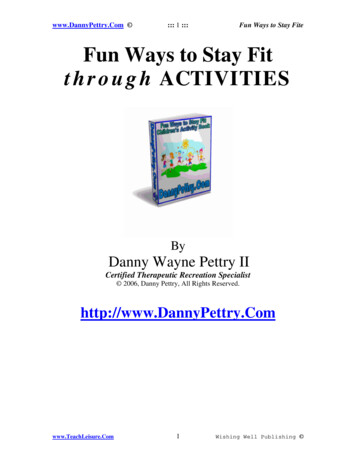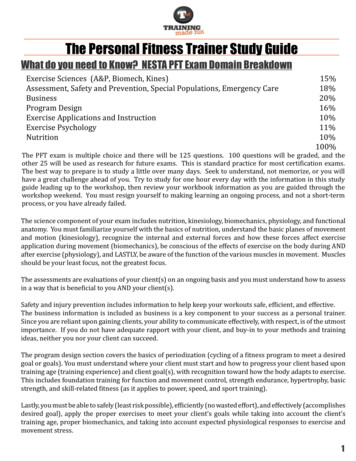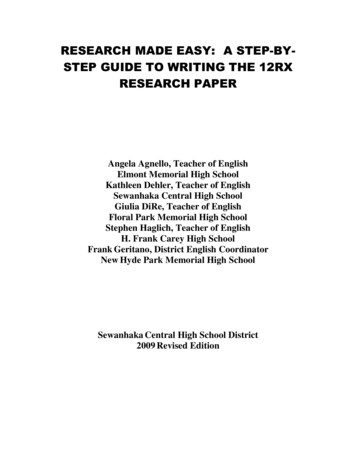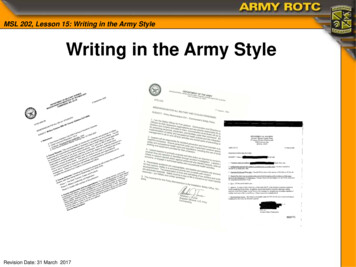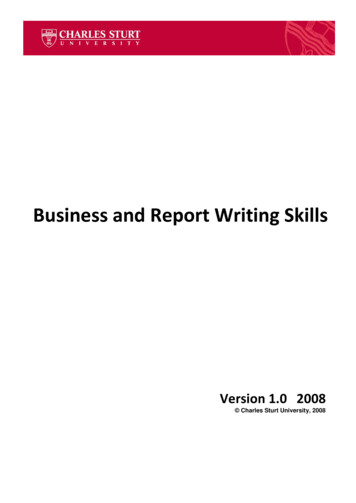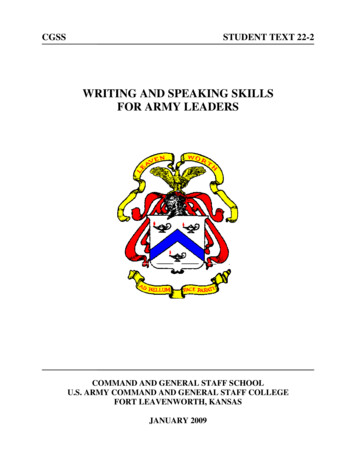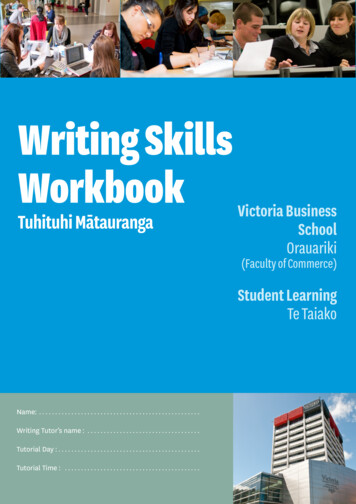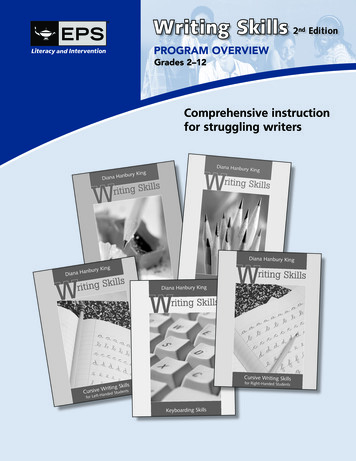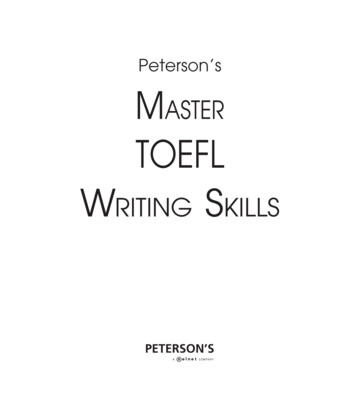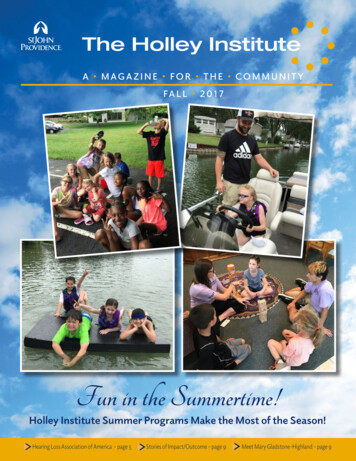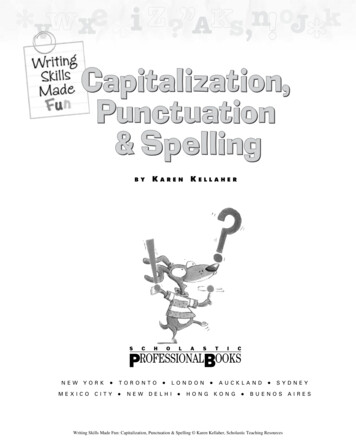
Transcription
CapitalizationBYNEWYORKMEXICO CITYKARENTORONTO NEW KELLAHERLONDONDELHI HONG AUCKLANDKONG SYDNEYBUENOSWriting Skills Made Fun: Capitalization, Punctuation & Spelling Karen Kellaher, Scholastic Teaching ResourcesAIRES
To my brother,Joseph Burns, Jr.Scholastic Inc. grants teachers permission to photocopy the activity pages in this book for classroom use. No other part ofthis publication may be reproduced in whole or in part, or stored in a retrieval system, or transmitted in any form or by anymeans, electronic, mechanical, photocopying, recording, or otherwise, without written permission of the publisher. Forinformation regarding permission, write to Scholastic Professional Books, 555 Broadway, New York, NY 10012.Front cover design by Kathy MassaroCover art by Mike MoranInterior design by Kathy MassaroInterior art by Mike MoranISBN: 0-439-22267-2Copyright 2001 by Karen Kellaher.Published by Scholastic Inc.All rights reserved.Printed in the U.S.A.Writing Skills Made Fun: Capitalization, Punctuation & Spelling Karen Kellaher, Scholastic Teaching Resources
CapitalizationContentsIntroduction .4Teaching With the Poem:“The Sentence-Enders” .6Capitalization . 8CAPITALIZATION WORKSHOP .8ACTIVITIESCapital Caps .9Capital Word Search .9Look for Capital Clues! .10Color-the-Capitals Riddle Game .10Kids’ Pages (Reproducibles) .11–13Sentence-Enders(Periods, Question Marks,Exclamation Points) .14SENTENCE-ENDERS WORKSHOP.14ACTIVITIESHow Does It End? Lift-the-Flap Book .15Sentence-Ender Search .15Sentence-Ender Mobile.16Kids’ Pages (Reproducibles) .17–19Apostrophes.30APOSTROPHE WORKSHOP.30ACTIVITIESApostrophe, the Letter-Eating ElfMini-Book .31Lost and Found Possessives Game .32Contraction Action! .32Kids’ Pages (Reproducibles) .33–37Spelling .38SPELLING WORKSHOP.38ACTIVITIESHomophone-Hunt Crossword Puzzle .39Word Clowns.39How Many Mistakes? .39Kids’ Pages (Reproducibles) .40–42Review .43Proofreading Checklist .43Proofreading Marks .43Who Wants to Be a Grammar Whiz? .43Kids’ Pages (Reproducibles).44–47Commas .20COMMA WORKSHOP .20ACTIVITIESBe a Comma Cop! .21The Comma-Cupboard Game .21Kids’ Pages (Reproducibles) .22–24Additional Resources .48Answers .48Quotation Marks .25QUOTATION MARKS WORKSHOP.25ACTIVITIESFairy Tale Quotes .26He Said, She Said Interview .26Use Your Noodles! .27Kids’ Pages (Reproducibles) .28–29Writing Skills Made Fun: Capitalization, Punctuation & Spelling Karen Kellaher, Scholastic Teaching Resources
noitcudortInWriting Skills Made Fun: About the Seriess a writer and editor in the field of educational publishing, I frequentlytalk with language-arts teachers about the kinds of tools they needmost. I also spend a lot of time browsing in bookstores and pagingthrough teacher catalogs, checking out what is currently available. One thing Inoticed over the past several years is that when it came to nitty-gritty writingskills, second- and third-grade teachers’ needs were simply not being met. Sure,there were plenty of grammar and writing resources available to teachers ofgrades 5, 6, and above. But I saw very little quality material that was just rightfor the early elementary grades. I wrote this series to fill that “grammar gap”—and to assist you in your all-important mission of teaching the rules of writing.As you are well aware, your job is cut out for you. According to state andnational standards, by the time students enter the second grade, they areexpected to know and understand the basic rules of English grammar, and toconsistently apply those rules to their own writing. Just take a look at some ofthe standards nationwide:A***CALIFORNIA: Second graders must be able to distinguish complete andincomplete sentences, use commas and quotation marks, and know when tocapitalize letters. Third-graders in the Golden State must be able to use allfour types of sentences, identify subjects and verbs, understand agreementand verb tenses, and identify and use all parts of speech.ILLINOIS: By the third grade, students should be able to construct completesentences that demonstrate subject-verb agreement, use punctuation andcapitalization properly, know and use the parts of speech, and demonstratefocus and organization when writing paragraphs.TEXAS: State standards dictate that by grade 3, “Students will recognize anddemonstrate appropriate use of standard English: usage, mechanics, spelling,and sentence structure.”As you know, with tough standards come tough tests. Almost all of the majorstandardized tests for third-graders include sections on usage and mechanics.And many tests include open-ended writing sections in which students mustdemonstrate that they know how to write using the basic rules of grammar.This book series, Writing Skills Made Fun is one way to help you meet thesecurriculum demands and make grammar and writing fun. The series includesthree books: Capitalization, Punctuation & Spelling; Parts of Speech; andSentences & Paragraphs.4Writing Skills Made Fun: Capitalization, Punctuation & Spelling Karen Kellaher, Scholastic Teaching Resources
IntroductionCapitalization, Punctuation, and SpellingTeaching students to capitalize, punctuate, and spell properly is one of the mostimportant tasks you face in teaching writing. These skills are essential to effectivewritten communication because they make the reader’s job easier. Students who donot master these skills will never write a winning essay, a reader-friendly letter, or astrong business memo. It will not matter that the writers have brilliant ideas oroutstanding stories to share: Their ideas will never be conveyed effectively. On theother hand, students who do master punctuation, capitalization, and spelling willhave some of the tools they need to execute clear and effective writing in any arena.In the second and third grades, your students have probably already begun tosense how much fun writing can be. It’s important to keep that excitement aliveby including a variety of enjoyable writing projects in your curriculum. Invitestudents to write adventure stories, lists, recipes, jokes, reports, book reviews,and more. In some cases, you may decide that students need not punctuate andspell correctly on a first draft of a story or in a journal entry that only they willread. That’s perfectly appropriate. However, it is very important to emphasizethat proper punctuation, capitalization, and spelling must be used whenpublishing or sharing one’s writing. Whether the final draft will be printed inthe school newspaper, displayed on the bulletin board, or handed in to you, itshould be polished and grammatically correct.In this book you’ll find dozens of activities to help you teach punctuation,capitalization, and spelling. The activities are interactive and age-appropriate—not the endless drill sheets you may remember from your own school days.From The Comma-Cupboard Game to the Homophone-Hunt CrosswordPuzzle, the lessons are sure to please both you and your students.You can use the activities and mini-lessons in any order you like. Check thelabel at the top of each lesson to see which major concepts are being explored.Other teaching tips follow:*Distribute copies of the grammar Workshop pages (found at the beginningof each chapter) for students to refer to as they complete the activities in thisbook. Students can bind these pages together and add a cover to make ahandy mini grammar reference book.***Have students work on some of the activities in collaborative groups.Students will learn from and build on one another’s ideas.Use the poem lesson on page 6 as the centerpiece of an excitingbulletin board or learning corner.Provide opportunities for students to share their work with classmates,parents, and others. For example, after you’ve made the How Does It End?Lift-the-Flap Book, encourage students to show it off at home. (Include a noteexplaining the purpose of the book.) Or organize a skit based on Apostrophe,the Letter-Eating Elf Mini-Book and perform it for another class.5Writing Skills Made Fun: Capitalization, Punctuation & Spelling Karen Kellaher, Scholastic Teaching Resources
IntroductionTeaching With the Poem:“The Sentence-Enders”One of the most fundamental grammar skills ispunctuation—knowing when to use periods,question marks, and exclamation points. Putthis information right at students’ fingertips byI wrote a sentence, my dear friend.Now I’ll put punctuation at the end.displaying this poem. It features an originalBut just which kind will all dependOn the message I’m trying to send.rhyme called “The Sentence-Enders.” TheIf I stated a fact or gave some news,Then a PERIOD is what I’ll use.rhyme’s memorable lyrics and beat will helpTry: “The saxophone player played the blues.”Or “I think that sweater is Mary Sue’s.”students learn to punctuate like pros!If I asked a question, though,A QUESTION MARK is the way to go.Display the poem in a central area of yourTry: “Did you stub your little toe?”Or “Have you ever seen such snow?”classroom. Recite it several times together, andAnd if I gave a command or excited cheer,then explore the poem with your class. PointAn EXCLAMATION POINT should appear.Try: “Fido, sit down over here!”out that the second half of each stanza (exceptOr “Driver, don’t forget to steer!”for stanza 1) provides an example of thepunctuation mark. Invite students to come upwith other examples of sentences that useperiods, question marks, and exclamationpoints. Write them on the board or on chart paper.To make the most of the poem, give students individual copies (see page 7).If you’re using the two companion books in this series (Parts of Speech andSentences & Paragraphs), distribute copies of the poems in those books as well.Have students make a grammar poem book by binding the poems together andadding a cover.Once students have mastered the three sentence-enders, invite them to writepoems of their own about other grammar rules. Possible topics include commas,quotation marks, commonly misspelled words, and capitalization. Students canuse the poem as a model or try their hand at a different form of poetry, such ashaiku or blank verse. A haiku is a three-linepoem, the first line of which has five syllables,the second line has seven syllables, and theC incinnatithird line has five syllables. Blank verse, orAugustfree verse, does not rhyme. Students canalso create an acrostic that uses the lettersPeter Panof a grammar-related word. For example,Indiathe acrostic at right utilizes words thatT hanksgivinrequire capital letters.gILLUSTRATIONBYMIKE MORANPoem copyright 2001 by Karen KellaherWriting Skills Made Fun: Capitalization, Punctuation & SpellingScholastic Professional BooksAuntie AnnL ulu LeopoldSuperman6Writing Skills Made Fun: Capitalization, Punctuation & Spelling Karen Kellaher, Scholastic Teaching Resources
Writing Skills Made Fun: Capitalization, Punctuation & Spelling Karen Kellaher, Scholastic Teaching Resources7ILLUSTRATIONBYMIKE MORANDatePoem copyright 2001 by Karen KellaherAnd if I gave a command or excited cheer,An EXCLAMATION POINT should appear.Try: “Fido, sit down over here!”Or “Driver, don’t forget to steer!”If I asked a question, though,A QUESTION MARK is the way to go.Try: “Did you stub your little toe?”Or “Have you ever seen such snow?”If I stated a fact or gave some news,Then a PERIOD is what I’ll use.Try: “The saxophone player played the blues.”Or “I think that sweater is Mary Sue’s.”I wrote a sentence, my dear friend.Now I’ll put punctuation at the end.But just which kind will all dependOn the message I’m trying to send.Name
noitazilatipaCWorkshopWriters use capital letters for a variety of purposes:To start a sentence:Dennis has a baby brother.We met at camp.To start proper nouns:America, July, LucyTo start adjectives that are formed from proper nouns:the American flag, a Victorian home, Chinese foodFor the personal pronoun “I”:Stella said I could come over after school.Jake is hungry but I am not.To begin and close a friendly lette
strong business memo. It will not matter that the writers have brilliant ideas or outstanding stories to share: Their ideas will never be conveyed effectively. On the other hand, students who do master punctuation, capitalization, and spelling will have some of the tools they need to execute clear and effective writing in any arena.
